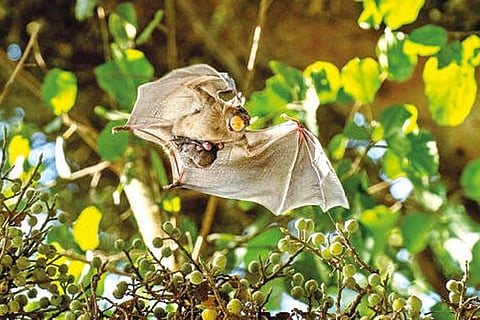

New York
Yet that’s how some baby bats learn to navigate, according to a study published last month in Current Biology. As their mothers tote them on nightly trips between caves and certain trees, the bat pups gain the skills they need to get around when they grow up.
Mothers of many bat species carry their young while flying, said Aya Goldshtein, a behavioural ecologist at the Max Planck Institute of Animal Behavior in Konstanz, Germany. Egyptian fruit bats, for example, are attached to their mothers continuously for the first three weeks of life.
While a mother searches for food, her pup clings to her body with two feet and its jaw, latching its teeth around her nipple.
Mothers can still be seen flying with older pups that weigh 40 percent of what they do. It hadn’t been clear why the moms go to this length, instead of leaving pups in the cave where they roost, as some other species do.
Dr. Goldshtein worked with Lee Harten, a behavioural ecologist at Tel Aviv University in Israel, where both she and Dr. Goldshtein were graduate students at the time in the lab of Yossi Yovel, a study co-author, to make sense of this maternal mystery.
The researchers captured Egyptian fruit bat mothers and pups from a cave just outside Tel Aviv. They attached a tag holding a radio transmitter and miniature GPS device to each bat’s fur that would drop off after a couple of weeks. Then, the researchers brought the bats back to their cave.
To track the bats, Dr. Harten held an antenna while standing on the roof of a 10-story building with a view of the cave. She directed Dr. Goldshtein, who was on foot or in a car with her own antenna, to follow the radio signals of bat pairs as they flew out at night. But again and again, there was a problem: The pup’s movement would suddenly stop, while the mother’s signal disappeared. “At the beginning we thought that we were doing our job wrong, and just losing the bats,” Dr. Harten said.
They needed the GPS data for better answers. That meant finding the GPS devices themselves — a challenge, because there was no way to control where the tags fell off the bats. They sometimes landed in roads or bushes; rats dragged them into their burrows. The scientists had to knock on doors and ask people to let them search their property. “You just need to have a lot of charm,” Dr. Goldshtein said.
It was more than a year into their project before they had enough data to realise their early results were no mistake. The signals of mother and baby bats had diverged because the mothers were carefully ditching their babies in trees while they searched for food.
“We couldn’t imagine that the mother would just leave a pup on a tree,” Dr. Goldshtein said. Over five years of field work, they discerned a clear picture of what was going on. When Egyptian fruit bats pups are a few weeks old, mothers carry them from the cave at the start of the night, as usual, then fly to a tree and leave them — sort of like day care drop-off, without supervision. The mother returns throughout the night, perhaps to nurse and warm up the pup. When she’s done foraging, she carries the pup home.
Visit news.dtnext.in to explore our interactive epaper!
Download the DT Next app for more exciting features!
Click here for iOS
Click here for Android